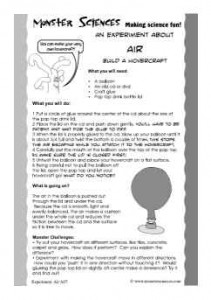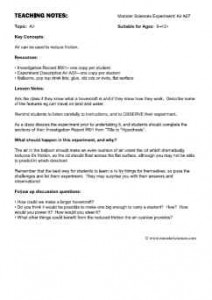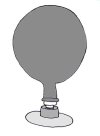Your students will love this experiment where they get to build and play with their very own hovercraft. They’ll learn how the air cushion reduces friction and allows the hovercraft to move.
 |
 |
An Experiment about Air: Build a Hovercraft
What you will need:
• A balloon
• An old cd or dvd
• Craft glue
• Pop top drink bottle lid
What you will do:
1 Put a circle of glue around the center of the cd about the size of the pop top drink lid.
2 Place the lid on the cd and push down gently. You’ll have to be patient and wait for the glue to dryl
3 When the lid is properly glued to the cd, blow up your balloon until it is about 3/4 full and twist the bottom a couple of times. This stops the air escaping while you attatch it to the hovercraft.
4 Carefully put the mouth of the balloon over the top of the pop top lid. Make sure the lid is closed first!
5 Untwist the balloon and place your hovercraft on a flat surface.
6 Being careful not to pull the balloon off the lid, open the pop top and let your hovercraft go! What do you notice?
What is going on?
The air in the balloon is pushed out through the lid and under the cd. Because the cd is smooth, light and evenly balanced, the air makes a cushion under the whole cd and reduces the friction bewteen the cd and the surface so it is free to move.
Monster Challenges:
• Try out your hovercraft on different surfaces, like tiles, concrete, carpet and grass. How does it perform? Can you explain the differece?
• Experiment with making the hovercraft move in different directions. How could you “push” it in one direction without touching it? Would glueing the pop top lid on slightly off centre make a dirrerence? Try it and find out!
TEACHING NOTES: Monster Sciences Experiment: Air A07
Topic:
Air
Key Concepts:
Air can be used to reduce friction.
Resources:
• Investigation Record IR01– one copy per student
• Experiment Description Air A07– one copy per student
• Balloons, pop top drink lids, glue, old cds or dvds, flat surface
Lesson Notes:
Ask the class if they know what a hovercraft is and if they know how they work. Describe some of the features eg can travel on land and water.
Remind students to listen carefully to instructions, and to OBSERVE their experiment.
As a class discuss the experiment prior to undertaking it, and students should complete the sections of their Investigation Report IR01 from ”Title to “Hypothesis”.
What should happen in this experiment, and why?
The air in the balloon should make an even cushion of air under the cd which dramatically reduces it’s friction, so the cd should float across the flat surface, although you may not be able to predict in which direction!
Remember that the best way for students to learn is to try things for themselves, so pose the
challenges and let them experiment. They may surprise you with their answers and observations!
Follow up discussion questions:
• How could we make a larger hovercraft?
• Do you think it would be possible to make one big enough to carry a student? How? How would you power it? How would you steer it?
• What other things could benefit from the reduced friction the air cushion provides?
Get this experiment here or as part of a bundle of Air Experiments here.
© www.monstersciences.com



